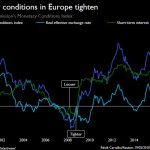The fundamental problem is that we don’t know what’s wrong. In many ways that is a worse condition because it is one step further removed from a solution. Even after ten years “we” still have to prove that the one thing everyone largely believes can’t be the depressing issue is.
Earlier this year as the price of oil began to slide all over again, the media was flooded by analysis of what would otherwise appear to be a grave contradiction. The trade in crude like many commodities is a signal of monetary conditions as much as fundamental imbalances. In fact, the two go hand in hand especially for oil, because the intersection of economy and finance is located practically in Cushing, OK.
In late June, Societe Generale’s Albert Edwards wrote:
After the [global financial crisis], central bankers have collectively spent the past decade stepping up the pace of money printing to new extremes in an attempt to drown the global economy in liquidity.
So why isn’t WTI $150 if not $200 a barrel? It’s the same mistake as was made in late 2014 and especially early 2015. Because for these people there is no monetary issue to speak of, the oil crash had to be due to a “supply glut”, and a “transitory” one at that.
It didn’t matter that slowing economic growth, which was obvious at the time, combined with commodity declines are textbook monetary deflation. The orthodoxy of QE overrode common sense and long-established principles. It was Economics over economics, and despite what has transpired since it still is.
Because of this misdiagnosis, there remains a great deal of confusion about the economy in 2017. In an orthodox, binary world of recession/not recession, the economy of this year no longer appears to be at risk for the former, so it is widely believed that in the category of “not recession” there can only be good things.
Factory orders were reported today as rising just 5.4% year-over-year (not seasonally-adjusted) in July 2017. After contracting for 22 months straight starting in October 2014 (the obvious slowing), 5% is nothing, barely any difference in strength or momentum. Even the prior month’s (June 2017) Boeing anomaly couldn’t push order growth into double digits (+9.3%) where it should be as a minimum for the scale (more so the duration parameter) of that contraction.



















Leave A Comment